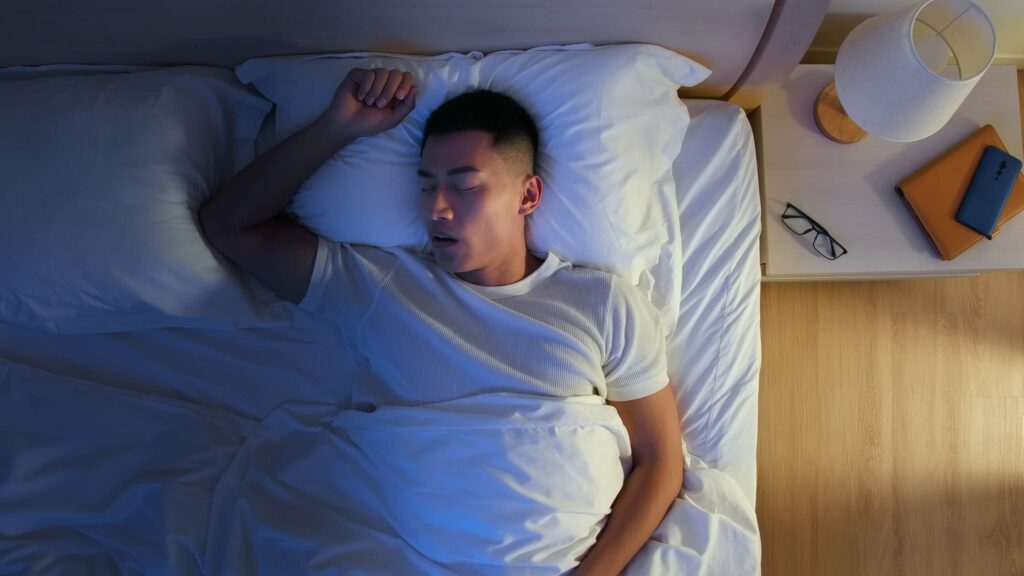
A little-known and poorly understood sleep disorder that occurs during the rapid eye movement, or REM, stage of sleep has been garnering attention for its role in foreshadowing neurodegenerative brain diseases such as Parkinson’s disease and dementia with Lewy bodies. The disorder, known as REM sleep behavior disorder, or RBD in the medical field, affects around 1% of the general population worldwide and about 2% of adults over 65.
The Conversation talked with Anelyssa D’Abreu, a neurologist who specializes in geriatric neurology, to explain what researchers know about the condition’s links to dementia.
1. What is REM sleep behavior disorder?
Every night, you go through four to five sleep cycles. Each cycle, lasting about 90 to 110 minutes, has four stages. That fourth stage is REM sleep.
REM sleep only comprises 20% to 25% of total sleep, but its proportion increases throughout the night. During REM sleep, your brain rhythms are similar to when you are awake, your muscles lose tone so you are unable to move, and your eyes, while closed, move quickly. This stage is often accompanied by muscle twitches and fluctuations in your respiratory rate and blood pressure.
But someone with REM sleep behavior disorder will act out their dreams. For reasons that are poorly understood, the dream content is usually violent – patients report being chased, or defending themselves, and as they sleep they shout, moan, scream, kick, punch and thrash about.
Injuries often result from these incidents; patients may fall from bed or accidentally harm a partner. Some 60% of patients and 20% of bed partners of people with this disorder sustain an injury during sleep.
Appropriate testing, including a sleep study, are needed to determine if a patient has REM sleep behavior disorder, as opposed to another disorder, such as obstructive sleep apnea. This is a disorder in which breathing is interrupted during sleep.
REM sleep behavior disorder can occur at any age, but symptoms usually start with people in their 40s and 50s. For those younger than 40, antidepressants are the most common cause of REM sleep behavior disorder; in these younger patients, it affects biological males and females about equally, but past age 50, it’s more common in biological males. https://www.youtube.com/embed/2nc8jUOQA1c?wmode=transparent&start=0 If you suspect you have REM sleep behavior disorder, see a sleep specialist or neurologist.
2. What causes REM sleep behavior disorder?
The disease mechanism is not well understood. In some cases of REM sleep behavior disorder, a clear cause cannot be identified. In other cases, the disorder may be caused by something specific, such as obstructive sleep apnea, narcolepsy, psychiatric disorders, use of antidepressants, autoimmune disorders and brain lesions, which are areas of damaged brain tissue.
In both situations, REM sleep behavior disorder may be associated with synucleinopathies, a group of neurodegenerative disorders in which aggregates of the protein α-synuclein accumulate in brain cells. The most common of these neurodegenerative disorders is Parkinson’s disease. Others are dementia with Lewy bodies, multiple system atrophy and pure autonomic failure. REM sleep behavior disorder may precede these diseases or occur at any time during the disease process. https://www.youtube.com/embed/kqaxHBx9Zsk?wmode=transparent&start=0 People with REM sleep behavior disorder can injure themselves – and their bed partners.
3. What are the links between the sleep disorder and dementia?
REM sleep behavior disorder may be the first symptom of Parkinson’s disease or dementia with Lewy bodies. It is observed in 25% to 58% of patients diagnosed with Parkinson’s, 70% to 80% of patients with dementia with Lewy bodies and 90% to 100% of those with multiple system atrophy.
In a long-term study of 1,280 patients with REM sleep behavior disorder who didn’t have parkinsonism – an umbrella term that refers to brain conditions, including Parkinson’s disease, that cause slowed movements, stiffness and tremors – or dementia, researchers followed participants to find out how many would develop these disorders. After 12 years, 73.5% of those with REM sleep behavior disorder had developed a related neurodegenerative disorder.
Some of the factors that independently increased the risk of developing a neurodegenerative disorder were the presence of irregular motor symptoms, abnormal dopamine levels, loss of sense of smell, cognitive impairment, abnormal color vision, erectile dysfunction, constipation and older age.
REM sleep behavior disorder may also be observed in other neurodegenerative disorders such as Alzheimer’s disease and Huntington’s disease, but at much lower rates. The association is also not as strong as that observed in the synucleinopathies.
4. Does an early diagnosis help?
For most neurodegenerative disorders, there is a phase that may last for decades in which brain changes are taking place but the patient either remains asymptomatic or develops symptoms without the full expression of the disease. RBD, in that scenario, is an early sign of those disorders. This provides an opportunity to study how the disease progresses in the brain and to develop therapies that could either slow this process or prevent it from happening.
At this time, there are no approved therapies to prevent the onset of these neurodegenerative diseases in those with REM sleep behavior disorder. There are, however, medications such as melatonin and clonazepam that may improve the symptoms. We also recommend measures to avoid injury, such as removing breakable objects from the room, protecting windows and padding floors.
Patients who are affected by REM sleep behavior disorder may choose to participate in research. Proper treatment of the disease can help prevent injury and improve quality of life.
Anelyssa D’Abreu, Associate Professor of Neurology, University of Virginia
This article is republished from The Conversation under a Creative Commons license. Read the original article.
Keep Reading: Better sleep for kids starts with better sleep for parents – especially after holiday disruptions to routines





